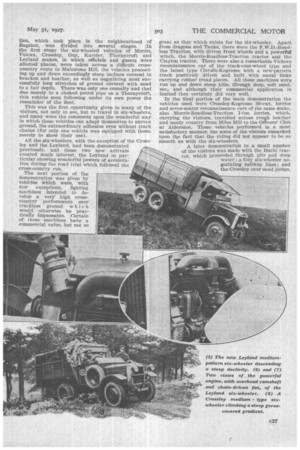CROSS-COUNTRY COLONIAL TRANSPORT.
Page 58

Page 59

If you've noticed an error in this article please click here to report it so we can fix it.
How the W.D. is Assisting the Overseas Civilian in Selecting Vehicles.
AFEW days age, at the invitation of the Secretary of State for War, we were present at a most interesting demonstration of cross-country transport vehicles, which had been arranged by the War Department in connection with the Colonial Office Conference as a means for showing, under most arduous conditions, the running and capabilities of the range of W.D. vehicles in the service of the Army.
It has long been recognized that the vehicle requirements of the War Department should, so far as possible, be co-ordinated with those of the civilian user, whether he be at home or overseas. This is the only way in which it is possible to obtain vehicles and tractors at a reasonable price and in the huge quail
titles which would be necessary in the event of another war on a really large scale in which this country would be concerned.
There is no doubt that for certain purposes, such as the haulage of really heavy artillery, special tractors must be employed, but ever, so, it may be that such tractors could be put to some civilian use in overseas work, such as in the hauling of a number of trailers, logging-, etc.
Where the rigid-frame six-wheeler is concerned, the possibilities are even greater, for this type of vehicle has proved itself to be almost as good in transport across country as a vehicle designed specifically for this purpose, whilst being even better than the ordinary four-wheeler for employment on the road. In fact, so cerLain are we of its undoubted advantages and outstanding capabilities that we believe it will soon be employed in large numbers in the ordins ary commercial transport of goods as well as in the conveyance of passengers, and the subsidy scheme recently inaugurated will, we believe, do much to expedite this advancement. Already a number of prominent users of road transport has purchased or ordered sixwheelers for goods carrying.
The actual demonstra tion, which took place in the neighbourhood of Bagshot, was divided into several stages. In the first stage the six-wheeled vehicles of Morris, Vulcan, Crossley, Guy, Karrier, Thornycroft and Leyland makes, in which officials and guests were allotted places, were taken across a difficult crosscountry route to Mainstone Hill, the vehicles proceeding up and down exceedingly steep inclines covered in bracken and heather, as well as negotiating most successfully long stretches of ground covered with sand to a fair depth. There was only one casualty and that due merely to a choked petrol pipe on a Thornycroft, this vehicle soon following under its own power the remainder of the fleet.
This was the first opportunity given to many of the visitors, not only to see, but to travel in six-wheelers, and many were the comments upon the wonderful way in which these vehicles can adapt themselves to uneven ground, the extraordinary adhesion even without track chains (for only one vehicle was equipped with these, merely to show their use).
All the six-wheelers, with the exception of the Crossley and the Leyland, had been demonstrated previously, and these two new arrivals created much interest, the Leyland in particular showing wonderful powers of acceleration during the road trial which followed the cross-country run.
The next portion of the demonstration was given by vehicles which were, with few exceptions, fighting machines intended to develop a very' high crosscountry performance over trackless ground which would otherwise be practically impassable. Certain of these machines have a commercial value, but not so great as that which exists for the six-wheeler. Apart from dragons and Tanks, there were the F.W.D.-Roadless Traction, with driven front wheels and a powerful winch, the Morris-Roadless-Traction tractor and the Clayton tractor. There were also a remarkable Vickers reconnaissance car of the track-cum-wheel type and the latest type Citron-Kegresse with a new-pattern track positively driven and built with metal links carrying rubber tread pieces. All these machines were run up and down steep hills, through deep, soft sand, etc., and although their commercial application is limited they certainly did very well.
In the final portion of the main demonstration the vehicles used were Crossley-Kegresse 30-cwt. lorries and seven-seater reconnaissance cars of the same make, also Morris-Roadless-Traction 1-ton lorries, which, carrying the visitors, travelled across rough heather and sandy country from Miles Hill to the Officers' Club at Aldershot. These vehicles performed in a most satisfactory manner, but some of the visitors remarked upon the fact that the riding did not appear to be so smooth as with the six-wheelers.
A later demonstration to a small number of the visitors was made with the Hathi tractor, which proceeded through pits and deep water ; a Guy six-wheeler negotiating railway lines; and the Crossley over sand jumps.












































































































